An Adaptive Inverse-Distance Weighting Interpolation Method Considering Spatial Differentiation in 3D Geological Modeling
Abstract
:1. Introduction
2. Research Method and Content
2.1. Basic Principles of the Data-Adaptive Inverse-Distance Weighting Interpolation Method Considering the Spatial Differentiation of Geological Information
2.1.1. Classical Inverse-Distance Interpolation Principle
2.1.2. The Principle of Spatial Differentiation of Geological Attribute Data
2.1.3. Principle of Data Adaptation Based on Geological Attributes
2.2. Implementation Steps of the Data-Adaptive Inverse-Distance Weighting Interpolation Method Considering the Spatial Differentiation of Geological Information
- Collect drilling data and unify the data format.
- Read basic observation borehole drilling information, target stratum drilling information, boundary borehole drilling information, and standard stratigraphic sequence information.
- Build and manage regional geological information collection in memory.
- Preprocess drilling data to include operations data; for example, by adding zero-thickness layers and marking unconventional stratigraphic sequence layers.
- Traverse stratums and generate the constrained Delaunay triangulation mesh according to the observation boreholes and boundary boreholes, scilicet making series of 2D planar surfaces (constrained Delaunay triangulation) for each geologic unit.
- Refine the triangular mesh according to the angle constraint and the side length constraint to obtain the interpolation point.
- Insert the interpolation points into the triangulation network in turn and calculate the interpolation results for each surfaces’ elevations according to the drill core data.
- Combine the interpolation results with the stratum data of each layer and output the geological model data in OBJ format.
2.3. Error Assessment
2.4. Efficiency-Error Assessment
2.5. Research Method and Content Summary
3. Research Results and Discussion
3.1. Case Overview
3.2. Research Result
3.2.1. Meshing
3.2.2. Drilling Model
3.2.3. Interpolated Geology Model
3.2.4. Geological Phenomenon Display
3.3. Results Discussion and Verification
4. Conclusions
Author Contributions
Funding
Institutional Review Board Statement
Informed Consent Statement
Data Availability Statement
Acknowledgments
Conflicts of Interest
References
- Dorninger, P.; Nothegger, C.; Djuricic, A.; Rasztovits, S.; Harzhauser, M. Smart-Geology for the World’s Largest Fossil Oyster Reef. In Proceedings of the EGU General Assembly Conference Abstracts; 2014; p. 10504. Available online: https://ui.adsabs.harvard.edu/abs/2014EGUGA..1610504D/abstract (accessed on 8 December 2020).
- Zhou, C.; Du, Z.; Gao, L.; Ming, W.; Ouyang, J.; Wang, X.; Zhang, Z.; Liu, Z. Key technologies of a large-scale urban geological information management system based on a browser/server structure. IEEE Access 2019, 7, 135582–135594. [Google Scholar] [CrossRef]
- Rus, G.-M.; Dulama, M.E.; Ursu, C.-D.; Colcer, A.-M.; Ilovan, O.-R.; Jucu, I.S.; Horvath, C. Online Apps, Web Sources and Electronic Devices: Learning through Discovery about Valea Ierii Iara Valley. In Proceedings of the 14th International Conference on Virtual Learning, Bucharest, Romania, 25–26 October 2019; pp. 110–119. [Google Scholar]
- Mei, G. Summary on several key techniques in 3D geological modeling. Sci. World J. 2014, 2014, 1–11. [Google Scholar] [CrossRef] [PubMed]
- Qiao, P.; Lei, M.; Yang, S.; Yang, J.; Guo, G.; Zhou, X. Comparing ordinary kriging and inverse distance weighting for soil as pollution in Beijing. Environ. Sci. Pollut. Res. 2018, 25, 15597–15608. [Google Scholar] [CrossRef] [PubMed]
- Wojciech, M. Kriging method optimization for the process of DTM creation based on huge data sets obtained from MBESs. Geosciences 2018, 8, 433. [Google Scholar] [CrossRef] [Green Version]
- Mallet, J.-L. Discrete smooth interpolation in geometric modelling. Comput. Des. 1992, 24, 178–191. [Google Scholar] [CrossRef]
- Wang, Y.; Akeju, O.V.; Zhao, T. Interpolation of spatially varying but sparsely measured geo-data: A comparative study. Eng. Geol. 2017, 231, 200–217. [Google Scholar] [CrossRef]
- Shepard, D. A two-dimensional interpolation function for irregularly-spaced data. In Proceedings of the 1968 23rd ACM National Conference, New York, NY, USA, 27–29 August 1968; pp. 517–524. [Google Scholar]
- Varatharajan, R.; Manogaran, G.; Priyan, M.K.; Balaş, V.E.; Barna, C. Visual analysis of geospatial habitat suitability model based on inverse distance weighting with paired comparison analysis. Multimed. Tools Appl. 2018, 77, 17573–17593. [Google Scholar] [CrossRef]
- Chen, F.W.; Liu, C.W. Estimation of the spatial rainfall distribution using inverse distance weighting (IDW) in the middle of Taiwan. Paddy Water Environ. 2012, 10, 209–222. [Google Scholar] [CrossRef]
- Ilker, A.; Terzi, Ö.; Şener, E. Yağışın Alansal Dağılımının Haritalandırılmasında Enterpolasyon Yöntemlerinin Karşılaştırılması: Akdeniz Bölgesi Örneği. Tek. Dergi 2019, 540, 9213–9219. [Google Scholar] [CrossRef]
- Ahrens, B. Distance in spatial interpolation of daily rain gauge data. Hydrol. Earth Syst. Sci. 2006, 10, 197–208. [Google Scholar] [CrossRef] [Green Version]
- Wang, G.; Huang, L. 3D geological modeling for mineral resource assessment of the Tongshan Cu deposit, Heilongjiang Province, China. Geosci. Front. 2012, 3, 483–491. [Google Scholar] [CrossRef] [Green Version]
- Li, Z.; Li, X.; Li, C.; Cao, Z. Improvement on inverse distance weighted interpolation for ore reserve estimation. In Proceedings of the 7th International Conference on Fuzzy Systems and Knowledge Discovery, Yantai, Shandong, China, 10–12 August 2010; Volume 4, pp. 1703–1706. [Google Scholar]
- Blewitt, G.; Coolbaugh, M.F.; Sawatzky, D.L.; Holt, W.; Davis, J.L.; Bennett, R.A. Targeting of potential geothermal resources in the Great Basin from regional to basin-scale relationships between geodetic strain and geological structures. Trans. Geotherm. Resour. Counc. 2003, 27, 3–7. [Google Scholar]
- Tabatabaei, S.H.; Salamat, A.S.; Ghalandasrzadeh, A.; Riahi, M.A.; Beitollahi, A.; Talebian, M. Preparation of engineering geological maps of Bam City using geophysical and geotechnical approach. J. Earthq. Eng. 2010, 14, 559–577. [Google Scholar] [CrossRef]
- Liu, H.; Chen, S.; Hou, M.; He, L. Improved inverse distance weighting method application considering spatial autocorrelation in 3D geological modeling. Earth Sci. Inform. 2020, 13, 619–632. [Google Scholar] [CrossRef]
- Zalakeviciute, R.; Bastidas, M.; Buenaño, A.; Rybarczyk, Y. A Traffic-based method to predict and map urban air quality. Appl. Sci. 2020, 10, 1–18. [Google Scholar] [CrossRef] [Green Version]
- Malvić, T.; Ivšinović, J.; Velić, J.; Rajić, R. Interpolation of small datasets in the sandstone hydrocarbon reservoirs, case study of the sava depression, Croatia. Geoscience 2019, 9, 201. [Google Scholar] [CrossRef] [Green Version]
- Babak, O.; Deutsch, C.V. Statistical approach to inverse distance interpolation. Stoch. Environ. Res. Risk Assess. 2009, 23, 543–553. [Google Scholar] [CrossRef]
- Barbulescu, A.; Bautu, A.; Bautu, E. Optimizing inverse distance weighting with particle swarm optimization. Appl. Sci. 2020, 10, 2054. [Google Scholar] [CrossRef] [Green Version]
- Lu, G.Y.; Wong, D.W. An adaptive inverse-distance weighting spatial interpolation technique. Comput. Geosci. 2008, 34, 1044–1055. [Google Scholar] [CrossRef]
- Li, Z.; Zhang, X.; Zhu, R.; Zhang, Z.; Weng, Z. Integrating data-to-data correlation into inverse distance weighting. Comput. Geosci. 2020, 24, 203–216. [Google Scholar] [CrossRef]
- Ozelkan, E.; Bagis, S.; Ozelkan, E.C.; Ustundag, B.B.; Yucel, M.; Ormeci, C. Spatial interpolation of climatic variables using land surface temperature and modified inverse distance weighting. Int. J. Remote Sens. 2015, 36, 1000–1025. [Google Scholar] [CrossRef]
- Roberts, E.A.; Sheley, R.L.; Lawrence, R.L. Using sampling and inverse distance weighted modeling for mapping invasive plants. West. N. Am. Nat. 2004, 64, 312–323. [Google Scholar] [CrossRef]
- Jing, L.; Stephansson, O. Explicit Discrete Element Method for Block Systems—The Distinct Element Method. Dev. Geotech. Eng. 2007, 85, 235–316. [Google Scholar] [CrossRef]
- Sun, L.; Wei, Y.; Cai, H.; Yan, J.; Xiao, J. Improved Fast Adaptive IDW Interpolation Algorithm based on the Borehole Data Sample Characteristic and Its Application. J. Phys. Conf. Ser. 2019, 1284, 22–24. [Google Scholar] [CrossRef] [Green Version]
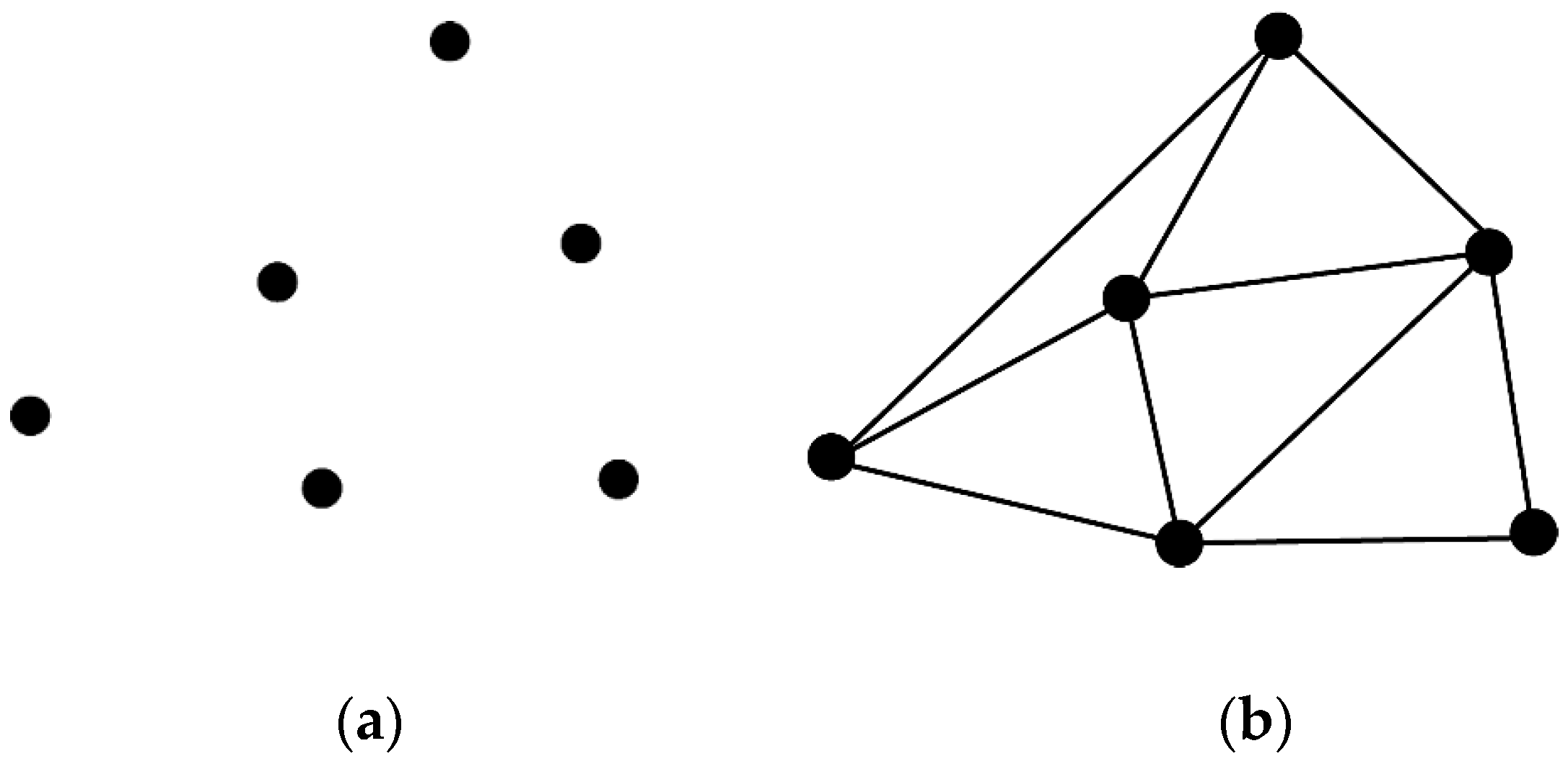
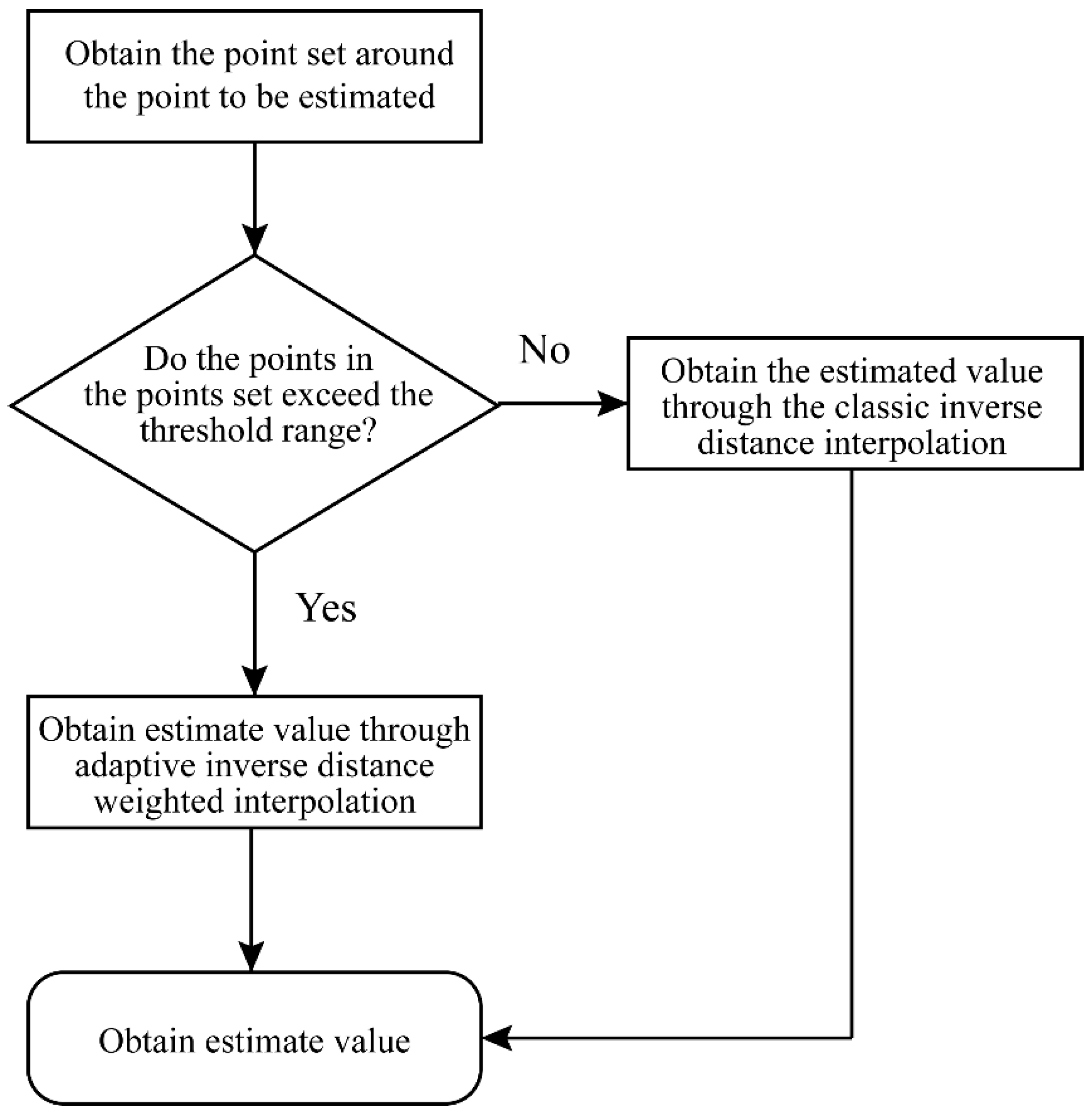

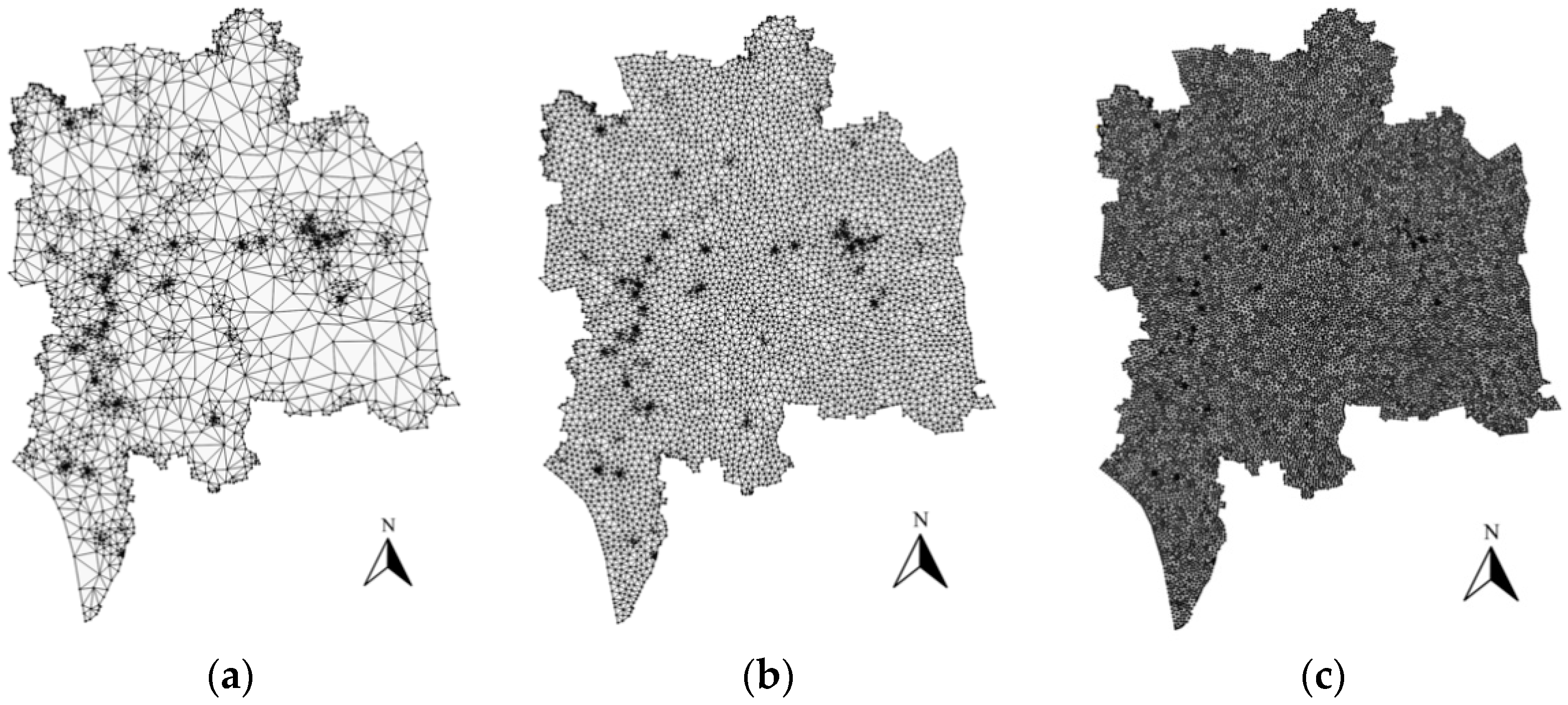
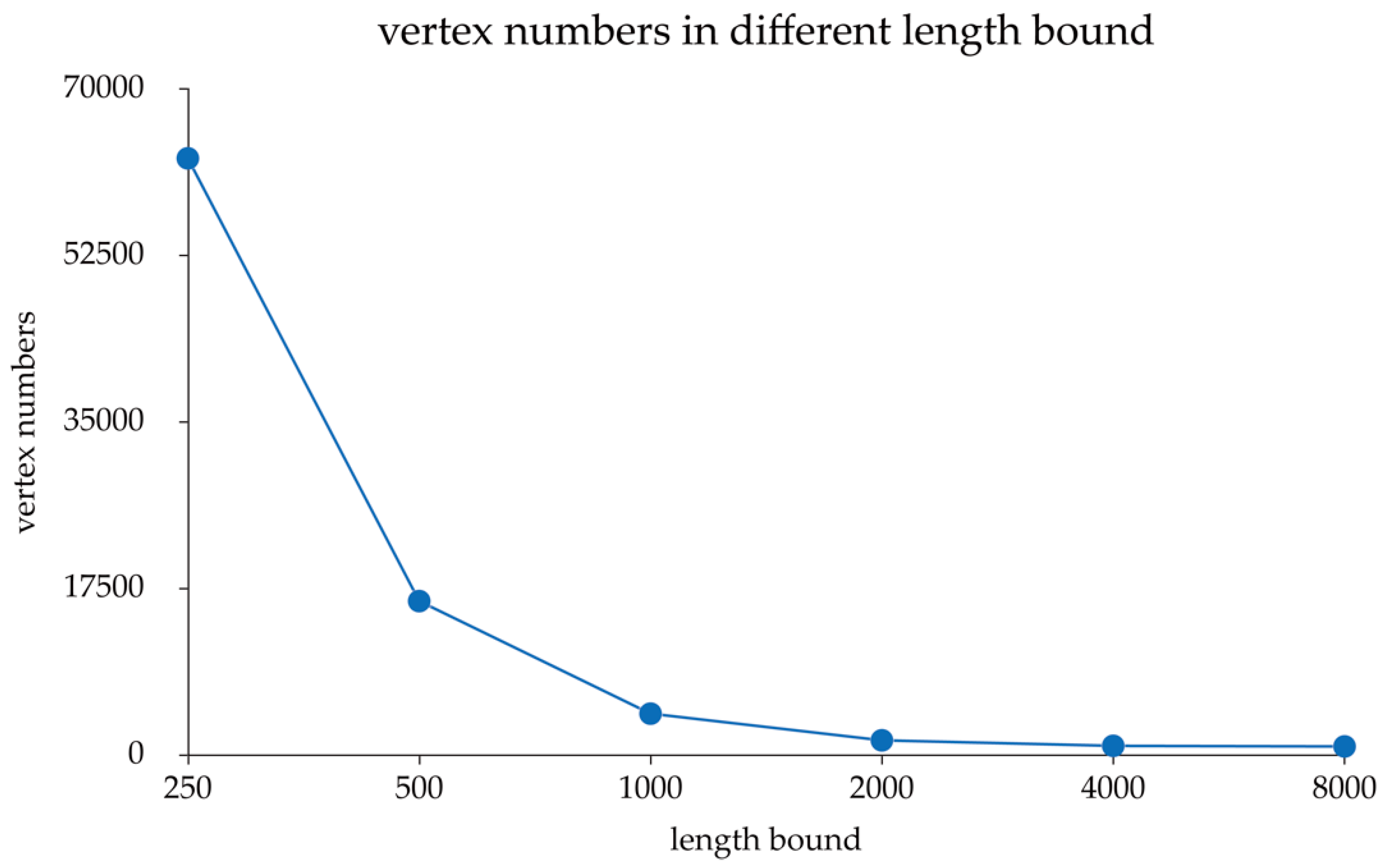
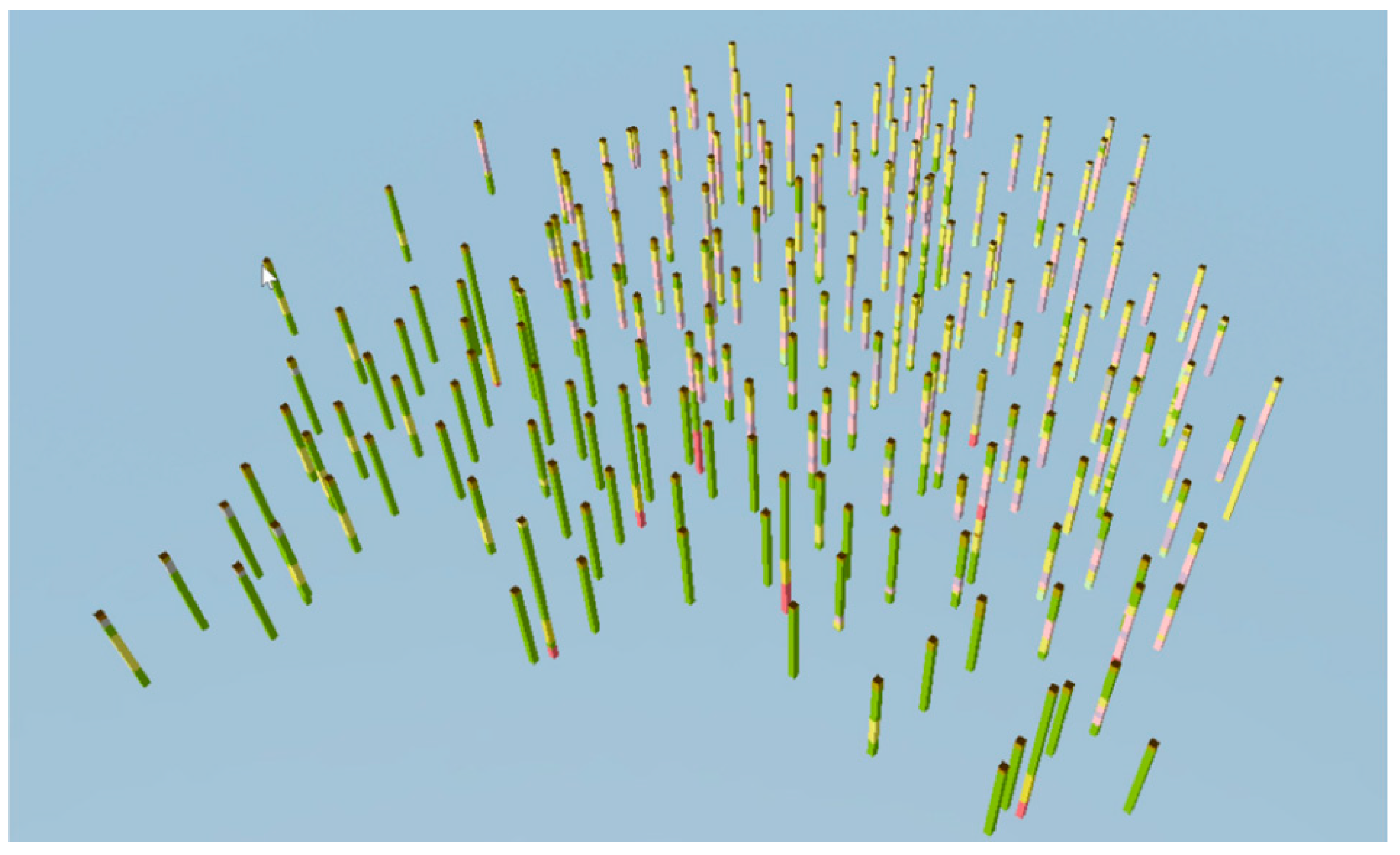
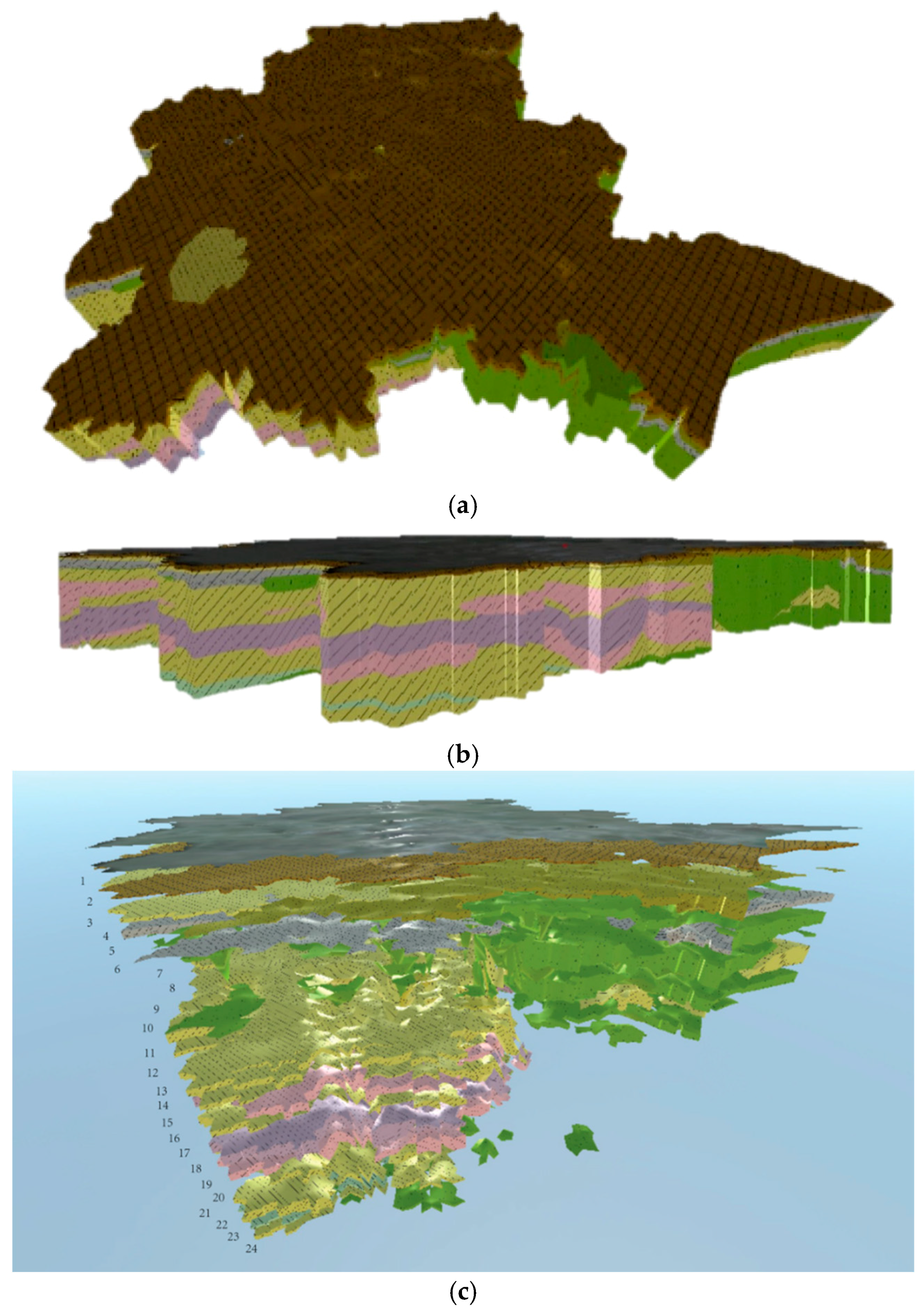

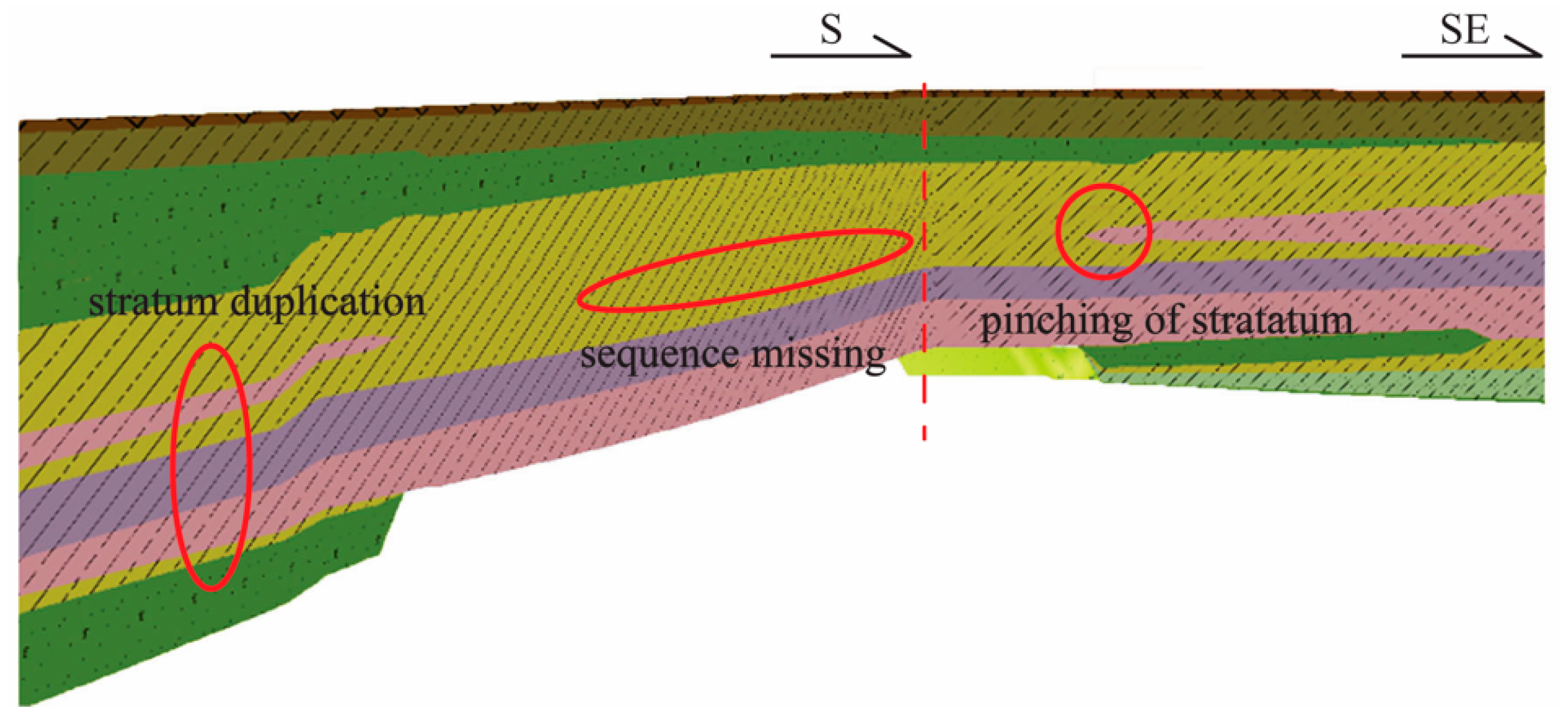
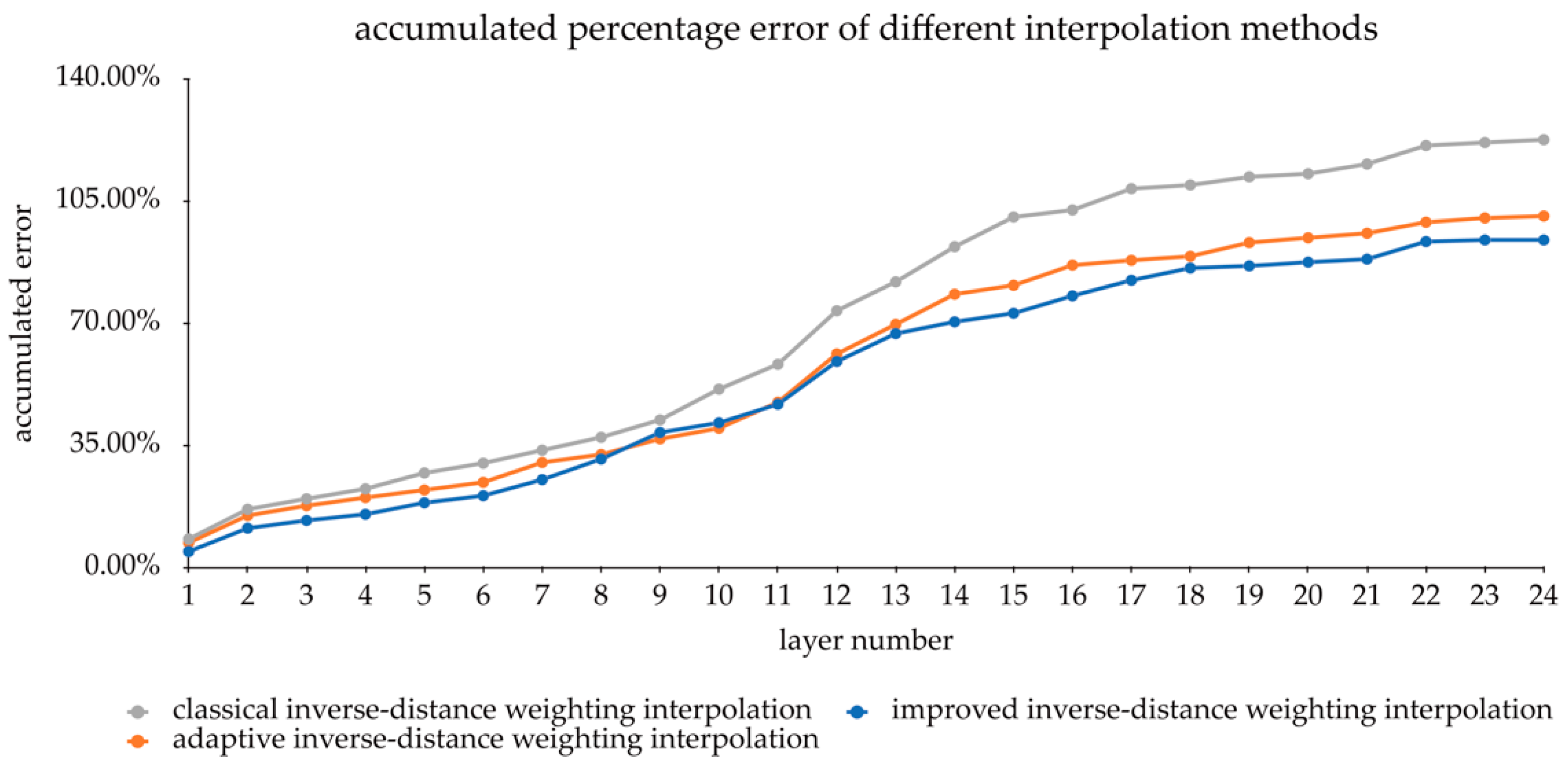


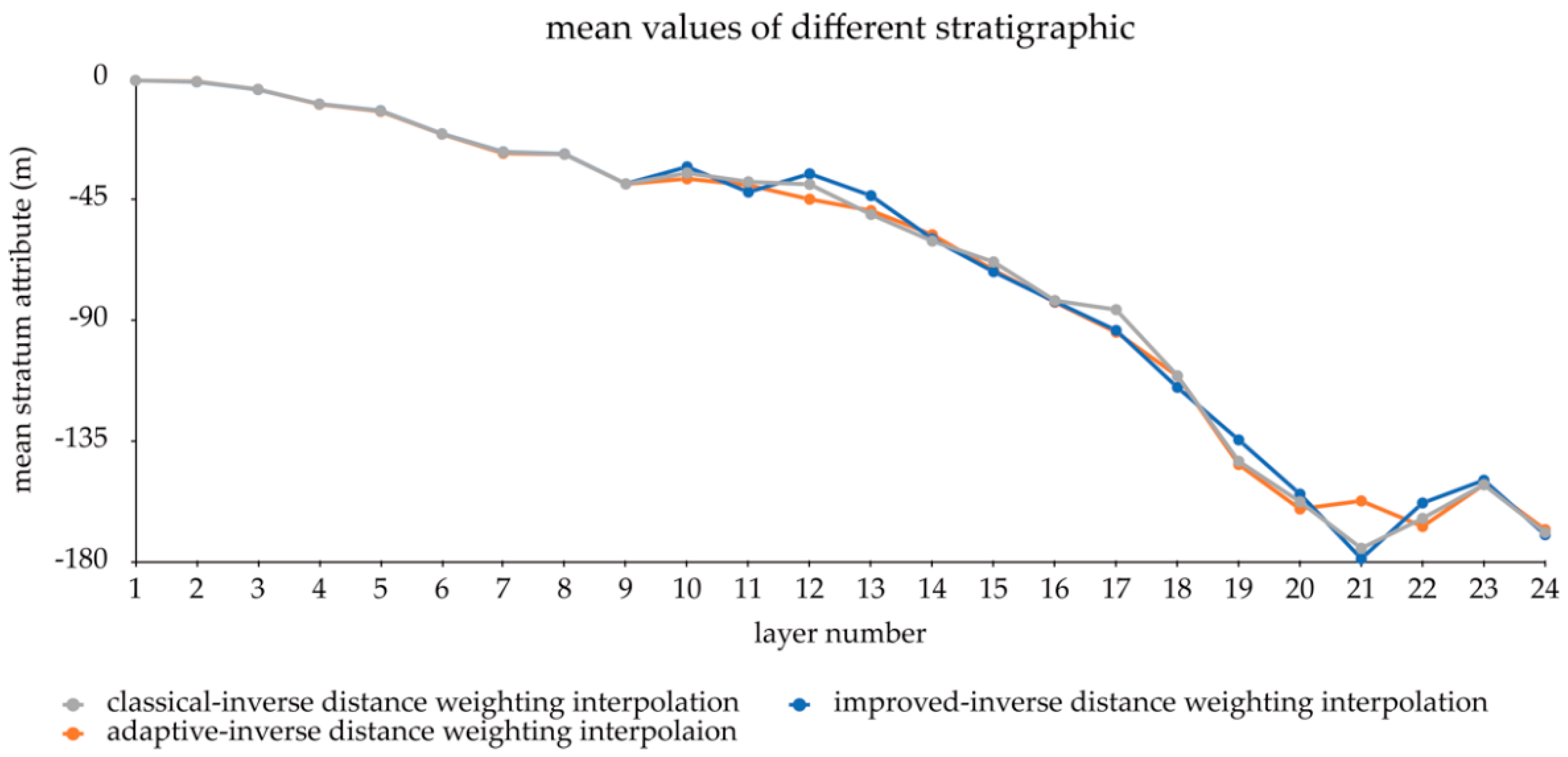
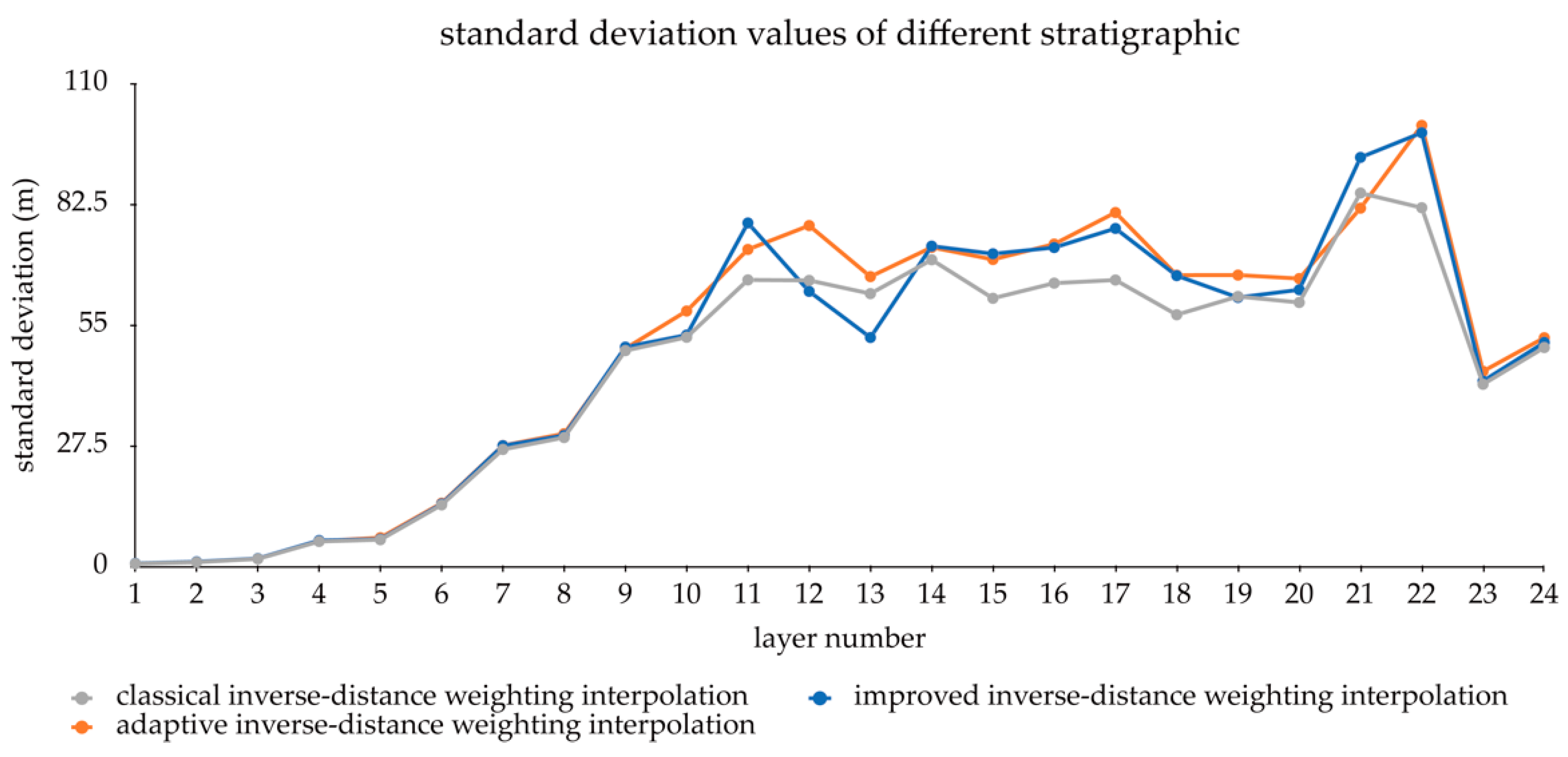
| Age | Layer Number | Sublayer Number | Layer Name | Distribution | Property |
|---|---|---|---|---|---|
| Holocene | 1 | 1 | fill soil | Universal distribution | Plain fill, miscellaneous fill, flush fill, etc. |
| 2 | 2–1 | silty clay | Universal distribution | Greyish yellow to grey, slightly wet to saturated, waxy to soft plastic | |
| 2–2 | silt | Universal distribution | Greyish yellow to grey, wet to saturated, loose to slightly dense | ||
| 2–3 | siltstone | Universal distribution | Grey, saturated, partially silty sand, slightly dense to moderately dense, with developed horizontal bedding | ||
| 2-4 | muddy silty clay | Local region | Grey to grey-brown, flowing plastic, high moisture content, high compressibility | ||
| 2–5 | siltstone | Yangtze River alluvial plain | Grey to blue-grey, partially mixed with silt or including thin layers of silty clay, water-saturated, medium to dense | ||
| 2–6 | siltstone | Yangtze River alluvial plain | Grey to blue-grey, thin layer of silty soil or silty clay, water-saturated, moderately dense to dense | ||
| 2–6b | silty clay | Yangtze River alluvial plain | Grey to taupe, saturated, flowing plastic, thin layer of silt with silt soil, well-developed bedding | ||
| 2–7 | siltstone | Yangtze River alluvial plain | Grey to blue-grey, water-saturated, moderately dense to dense, well-developed bedding, with thin layer of silty clay partially intercalated | ||
| Late Pleistocene | 3 | 3–1 | siltstone(fine sand) | Yangtze River alluvial plain | Grey to grey-yellow, water-saturated, moderately dense to dense, with thin layers of cohesive soil in some areas, with well-developed bedding |
| 3–2 | fine sand(medium and coarse sand) | Yangtze River alluvial plain | Grey to grey-yellow, water-saturated, compact, lithology is fine gravel sand, with medium- to coarse-grained gravel sand, gravel layers, etc. | ||
| 4 | 4–1 | silty clay | Lixiahe plain | Grey-yellow to dark green, saturated, plastic to soft plastic, iron-manganese nodules, medium compressibility | |
| 4–2 | silty clay | Lixiahe plain | Grey-yellow to brown-yellow, dark green, iron-manganese nodules and calcium nodules, saturated, hard plastic to plastic, medium-low compressibility | ||
| 4–3 | silty clay mixed with silt | Lixiahe plain | Grayish yellow to grey, mixed with silt, saturated, plastic, moderate compressibility, horizontal bedding is relatively developed | ||
| 5 | 5–1 | silt, siltstone | Lixiahe plain | Mainly grey, grey-yellow in some areas | |
| 5–2 | silty clay | Lixiahe plain | Grey, saturated, soft-flow plastic, horizontal bedding development | ||
| 5–3 | siltstone | Lixiahe plain | Grey, saturated, moderately dense to dense | ||
| 6 | 6 | cay, silty clay | Lixiahe plain | Lacustrine sediments, distributed in the Lixiahe plain | |
| 7 | 7–1 | silt, siltstone | Lixiahe plain | Greyish yellow, blue-grey, water-saturated, moderately dense to dense, well-layered | |
| 7–2 | silty clay | Lixiahe plain | Greyish yellow, blue-grey, saturated, plastic-soft plastic, bedding is relatively developed | ||
| Middle Pleistocene | 8 | 8–1 | siltstone, fine sand | Yangtze River alluvial plain | Grey, greyish yellow, part of the area is medium sand, partly with gravel and dense |
| 8–2 | gravel sand (gravel layer) | Yangtze River alluvial plain | Mainly grey, partially greyish yellow, with large lithological changes | ||
| 9 | 9–1 | silty clay | Lixiahe plain | Cyan-grey to grey-yellow, saturated, mainly hard plastic but can also be partially plastic, containing iron-manganese nodules and calcium nodules | |
| 9–2 | silty clay with silt | Lixiahe plain | Greyish yellow grey, saturated, plastic-soft plastic, high silt content, well-developed layering | ||
| 9–3 | silty clay | Lixiahe plain | Cyan-grey to yellow, saturated, hard plastic to partially plastic |
| Strata Number | Classical | Adaptive |
|---|---|---|
| 1 | 0.04 | 0.02 |
| 2 | 0.23 | 0.02 |
| 3 | 0.83 | 0.43 |
| 4 | 1.58 | 1.05 |
| 5 | 2.45 | 2.20 |
| 6 | 3.40 | 3.54 |
| 7 | 4.73 | 4.89 |
| 8 | 7.02 | 11.47 |
| 9 | 11.52 | 17.45 |
| 10 | 13.10 | 24.27 |
| 11 | 14.57 | 44.03 |
| 12 | 15.84 | 49.95 |
| 13 | 17.35 | 55.73 |
| 14 | 18.51 | 57.84 |
| 15 | 19.47 | 60.08 |
| 16 | 20.67 | 62.32 |
| 17 | 21.85 | 65.76 |
| 18 | 23.18 | 71.56 |
| 19 | 24.47 | 74.58 |
| 20 | 25.82 | 77.59 |
| 21 | 27.07 | 80.60 |
| 22 | 28.37 | 85.04 |
| 23 | 29.68 | 89.03 |
| 24 | 30.98 | 92.74 |
Publisher’s Note: MDPI stays neutral with regard to jurisdictional claims in published maps and institutional affiliations. |
© 2021 by the authors. Licensee MDPI, Basel, Switzerland. This article is an open access article distributed under the terms and conditions of the Creative Commons Attribution (CC BY) license (http://creativecommons.org/licenses/by/4.0/).
Share and Cite
Liu, Z.; Zhang, Z.; Zhou, C.; Ming, W.; Du, Z. An Adaptive Inverse-Distance Weighting Interpolation Method Considering Spatial Differentiation in 3D Geological Modeling. Geosciences 2021, 11, 51. https://doi.org/10.3390/geosciences11020051
Liu Z, Zhang Z, Zhou C, Ming W, Du Z. An Adaptive Inverse-Distance Weighting Interpolation Method Considering Spatial Differentiation in 3D Geological Modeling. Geosciences. 2021; 11(2):51. https://doi.org/10.3390/geosciences11020051
Chicago/Turabian StyleLiu, Zhen, Zhilong Zhang, Cuiying Zhou, Weihua Ming, and Zichun Du. 2021. "An Adaptive Inverse-Distance Weighting Interpolation Method Considering Spatial Differentiation in 3D Geological Modeling" Geosciences 11, no. 2: 51. https://doi.org/10.3390/geosciences11020051





